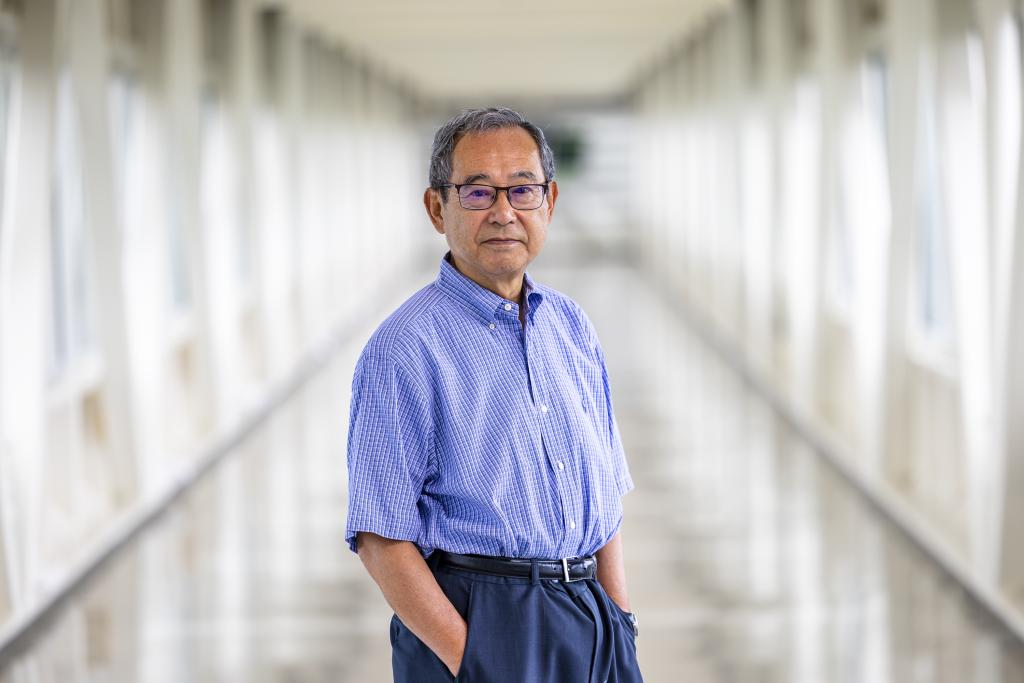
In 1543, Copernicus pitched the heliocentric idea that the Earth orbited the sun. His theory took 150 years to catch on and more than 400 years for the Vatican to officially accept it. Likewise, distinguished materials scientist Takeshi Egami has spent his career revealing the complex atomic structure of metallic glass and other liquids — sometimes sharing theories with initially resistant minds in the scientific community. However, he is willing to go the distance to bring his colleagues on board to his latest discoveries.
The noncrystalline, amorphous atomic structure of liquids and glasses is, quite literally, all over the place. The landscape is chaotic: disorderly atoms are scattered about like tapioca pearls in a freshly shaken boba tea.
Egami studies these materials at the Department of Energy’s Oak Ridge National Laboratory and the University of Tennessee, Knoxville, or UTK. He directed the UT-ORNL Joint Institute for Neutron Sciences from 2008 to 2015. Egami and his colleagues in ORNL’s Materials Science and Technology Division use neutron scattering and synchrotron X-ray to see, with increasing clarity, the structure, dynamics, transition and deformation of noncrystalline materials.
In crystalline solids, atoms bond together and are arranged in a rigid, jungle gym-like structure called a lattice. This lattice is what makes most solids — such as jewelry, refrigerators and high-rise buildings — solid.
“There’s not much freedom for atoms to move around,” said Egami. “A crystalline structure is like an autocracy where each atom must behave like every other atom. A liquid is like a democracy where atoms may move about more.” Structural analysis is challenging since atoms are in constant disarray.

The typical method of atomic modeling is a bottom-up approach in which each atom connects with its closest neighboring atoms. This method works reliably for most solids, but bottom-up analysis of noncrystalline materials has always made Egami uneasy because of their unstable, chaotic nature. “The bottom-up approach is very self-centered, like the geocentric view of the universe where the Earth is at the center,” he said. Like Copernicus, Egami has looking for the cosmic truth about these materials his whole career.
After completing undergraduate studies in applied physics at the University of Tokyo, a doctorate in materials science from the University of Pennsylvania and postdoctoral studies at the University of Sussex and the Max Planck Institute, Egami taught at the University of Pennsylvania for 30 years. In 2003, he came to ORNL where to focus on the underdeveloped field of liquid physics.
“Water itself is a major mystery,” said Egami. “The classical physics of water is well understood, but there are many things about water we don’t understand. It’s such basic stuff, right? Life came out of that, and we don’t know why.”
Egami uses enigmatic metallic glass to study the structure, function and deformation of noncrystalline materials.
Metallic glass presents as solid, but its disorganized atomic structure makes it technically a frozen liquid. The opaque substance is made of metal alloys — made by mixing two or more metallic elements — that are supercooled so atoms do not have a chance to organize themselves into a lattice structure.
This lack of structure makes metallic glass highly elastic, extremely strong and easy to magnetize. Since entering the marketplace in the 1970s, metallic glass has been used in products such as sporting goods, smartphones and medical devices. Still, not much is known about the source of its mechanical properties, which has limited its commercial use.

For example, for all its strength, metallic glass is extremely fragile. Give a golf ball one too many whacks with a club made of it, and the club will shatter. Current theories about metallic glass cannot describe this kind of weirdness.
Egami’s research has begun to suggest structural and functional behavior of noncrystalline materials that defies prevailing theory. He hopes these findings lead to changes in analysis that have wide scientific impact.
In 2017 using synchrotron X-rays at the SPring-8 facility in Japan, Egami and his group showed, for the first time, dynamic atomic correlation in water. The correlations are measures of how much the movement of one atom is influenced by the presence of others. “Everybody knows about these correlations, but no one had seen them before,” said Egami. “Now, we can see how atoms relate in space and time, for the first time.”
The journey to a new density wave theory began with Egami’s uneasiness with bottom-up atomic modeling. With a wider look, his new approach began with the medium-range order — the correlation of a single atom and its surrounding atoms at a distance up to 10 times the atomic size.
“I always thought maybe there’s a global way of looking at it, not just local,” he said. “Why can’t we look at the whole system at once?” A 2022 paper by Egami and UTK’s Chae Woo Ryu described a density wave state, or ripple. Evidence of this ripple had been observed before but was interpreted as noise in the experimental data caused by X-ray scattering. In 2019, Egami’s team used a novel experimental method of liquid levitation under vacuum that removed the noise and confirmed that the ripples are real. This finding ushered in the density wave theory and a new hypothesis on the relationship between the bottom-up and top-down methods.
“Sometimes the conflict can create something totally new,” said Egami. The competition between the bottom-up and top-down observations prompted Egami and colleagues to propose a new medium-range order that may hold the key to viscosity and deformation in liquids and glasses. Egami hopes these findings will shatter the metallic glass ceiling and gain traction beyond the world of the samples they were tested on.

Scientists calculate and predict electron behaviors of complex systems using density functional theory. “Chemists use this all the time because it’s easier than running an experiment,” said Egami. But the calculation is not ideal for materials in which electrons are strongly correlated, such as magnets or high-temperature superconductors. Using the same approach for electrons as he used for liquids, Egami has succeeded in seeing electron correlation. “Since we can see dynamic electron correlation, we no longer need to rely on density functional theory.”
The esteemed materials scientist is taking his findings on the road and has embarked on a one-man talking tour. “I know this will take some time to catch on,” he said. Although his findings have met resistance in other disciplines, he is used to it. “It’s not my first rodeo,” Egami said, speaking of his co-authored book that proposed — initially to great resistance — a new method of analyzing disorganized crystals.
After 10 years of persuasion, colleagues finally came around. Egami’s analysis technique, detailed in Underneath the Bragg Peaks, is now standard in the field. For the proposed density wave theory and medium-range order of metallic glasses, “I’m in no hurry,” Egami said. He is optimistic that his theory’s acceptance will not take long as it did for Copernicus.
The DOE Office of Basic Energy Sciences funds Egami’s work. His research primarily relies on the Spallation Neutron Source, a DOE Office of Science user facility at ORNL.
UT-Battelle manages ORNL for DOE’s Office of Science. The single largest supporter of basic research in the physical sciences in the United States, the Office of Science is working to address some of the most pressing challenges of our time. For more information, please visit energy.gov/science. — Christy White


